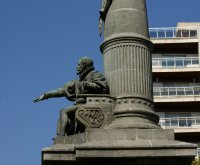3. Aragón Square

The so-called Glorieta de Pignatelli, at present Aragón Square, gathers five commemorative monuments from different ages, authors and styles. This area has suffered different changes, for instance the garden has been suppressed and the size of the square has increased, affecting the views. Despite these changes, the Monument to the Justicia of Aragón Juán de Lanuza continues to be its main landmark. The project, made by the architect Félix Navarro, with a complex iconographic development and a clear regional exaltation, was placed at the centre of the square, which forced the Municipality to find a new place for the Monument to Ramón Pignatelli.
The above mentioned trend of commissioning monumental works to non-local artists, started in the first decade of the 20th century, and the confirmation was Lanuza Statue, made by the Galician Francisco Vidal de Castro. Nevertheless, this trend was broken by the works of art at both sides of the above mentioned statues, which were made by two of the most valued Aragonese sculptors of their age, José Bueno and Félix Burriel -even though Bueno reached a bigger national prestige. We can see an important number of works made by both sculptors in the streets of Zaragoza.
At present, those busts -all of them devoted to intellectuals such as poets, writers and playwrighters- have become smaller in a certain way, due to the dimensions of the central monument and after the demolition of the garden that isolated and distinguished them. The busts form a homogeneous group, since all of them answer to a common trend, usual in that age, consisting of bronze bust put on a simple stone base. Both works made by Bueno -the Monument to Cavia and the Monument to Fernando Soteras "Mefisto" were planned immediately after the dead of these celebrities, as it happened in the same period with others such as the Monument to Doctor Félix Cerrada. Scarce time had also passed from the dead of Marcos Zapata, when the idea of pay him homage came up, and some decades passed to make a reality those of Julio Monreal and Ximénez de Embún. All of them were directly commissioned to these artists without public bid.